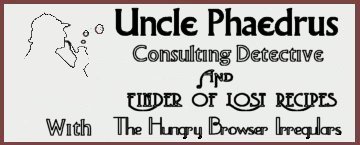|
From: Dawn
Sent: Saturday, September 30, 2017 7:05 PM
To: phaedrus@hungrybrowser.com
Subject: Cucumber/onion/sour cream/salad
Hello again my friend. This time it is for a favorite salad from many years ago.
I know it had thinly sliced cucumbers & onions which were soaked in salted water and
put in fridge for an hour or so, then squeezed to get the excess fluids out.
Various things were then added: sour cream, vinegar etc.
I would love to get this recipe back in my cookbook.
Thanks as usual. Dawn
Hi Dawn,
Finding that exact recipe is problematic, but this one is very similar: Viroqua Food
Phaed
From: rntlc21
Sent: Friday, September 29, 2017 1:30 AM
To: phaedrus@hungrybrowser.com
Subject: Green goddess dressing Evangeline cafe pascagoula, ms
Have tried to obtain this recipe for years. My mother was a waitress there years ago.
She would take us there to eat. This dressing was good you could eat it like soup.
My mother died many years ago. If you could help me find this recipe. Many thanks.
rntlc21.
Hello rntlc21,
Please give your first name. It’s a requirement.
I had no success locating this recipe.
The Evangeline Restaurant in Pascagoula, MS was owned by Jake (James F.) and Trina Velcich.
You might be able to get this recipe if you can locate one of their four daughters.
I do not know their names.
Your best bet might be to post your request on these Facebook pages:
Pascagoula, Remember When
Old Biloxi Recipes
Phaed
Mark Twain spent a lot of time traveling, which gave him fodder for many of his books.
His travel books include: "The Innocents Abroad" - His best-selling book during his
lifetime, about his trip to Southern Europe and the Middle East, "Roughing It" - about
his trip from Missouri to Nevada by stagecoach and his life in Nevada and San Francisco,
"A Tramp Abroad" - about a trip to Europe, and "Following the Equator" (sometimes called
"More Tramps Abroad") - about his trip around the world.
What does Mark Twain have to do with food and recipes? Well, in "A Tramp Abroad", Twain
began reminiscing about the American food that he was sorely missing while in Europe, and
he made up a list of those foods, calling it "a little bill of fare"
and saying this about it:
It has now been many months, at the present writing, since I have had a nourishing meal,
but I shall soon have one—a modest, private affair, all to myself. I have selected a few
dishes, and made out a little bill of fare, which will go home in the steamer that precedes
me, and be hot when I arrive—as follows:
Radishes. Baked apples, with cream. Fried oysters; stewed oysters. Frogs. American coffee,
with real cream. American butter. Fried chicken, Southern style. Porter-house steak.
Saratoga potatoes. Broiled chicken, American style. Hot biscuits, Southern style.
Hot wheat-bread, Southern style. Hot buckwheat cakes. American toast. Clear maple syrup.
Virginia bacon, broiled. Blue points, on the half shell. Cherry-stone clams. San Francisco
mussels, steamed. Oyster soup. Clam Soup. Philadelphia Terapin soup. Oysters roasted in
shell-Northern style. Soft-shell crabs. Connecticut shad. Baltimore perch. Brook trout,
from Sierra Nevadas. Lake trout, from Tahoe. Sheep-head and croakers, from New Orleans.
Black bass from the Mississippi. American roast beef. Roast turkey, Thanksgiving style.
Cranberry sauce. Celery. Roast wild turkey. Woodcock. Canvas-back-duck, from Baltimore.
Prairie hens, from Illinois. Missouri partridges, broiled. ‘Possum. Coon. Boston bacon
and beans. Bacon and greens, Southern style. Hominy. Boiled onions. Turnips. Pumpkin.
Squash. Asparagus. Butter beans. Sweet potatoes. Lettuce. Succotash. String beans.
Mashed potatoes. Catsup. Boiled potatoes, in their skins. New potatoes, minus the skins.
Early rose potatoes, roasted in the ashes, Southern style, served hot. Sliced tomatoes,
with sugar or vinegar. Stewed tomatoes. Green corn, cut from the ear and served with
butter and pepper. Green corn, on the ear. Hot corn-pone, with chitlings, Southern style.
Hot hoe-cake, Southern style. Hot egg-bread, Southern style. Hot light-bread, Southern style.
Buttermilk. Iced sweet milk. Apple dumplings, with real cream. Apple pie. Apple fritters.
Apple puffs, Southern style. Peach cobbler, Southern style Peach pie. American mince pie.
Pumpkin pie. Squash pie. All sorts of American pastry. Fresh American fruits of all sorts,
including strawberries which are not to be doled out as if they were jewelry, but in a more
liberal way. Ice-water—not prepared in the ineffectual goblet, but in the sincere and capable
refrigerator.
There is a book by Andrew Beahrs called Twain's Feast: Searching for America's Lost Foods
in the Footsteps of Samuel Clemens that uses Twain's "little bill of fare" as a starting
point. Beahrs wanted to experience some of the foods on Twain's list and so he worked to
recreate them, even if he had to travel to distant locations to find them. He begins with
breakfast, which he is able to make himself, consisting of biscuits, steak, and buckwheat
cakes. He then pursues some of the more difficult delicacies, such as prairie chickens in
Newton, Illinois; raccoon in Gillett, Arkansas; trout in Lake Tahoe; oysters and mussels in
San Francisco; terrapin in Maryland, croakers and sheepshead in New Orleans; cranberries in
Massachusetts; and maple syrup in Connecticut. Beahrs' book only covers a small part of
Twain's "bill of fare", and he digresses quite a lot into Twain's life and into local color
about the places he visits. Worthwhile reading.
What puzzles me about Twain's original list in "A Tram Abroad" are the items that aren't:
on the list: grits, fried catfish from the Mississippi, hush-puppies, sausage gravy, barbecue
of any kind, gumbo and other Creole/Cajun dishes, black-eyed peas, and shrimp dishes of any sort.
If you want recipes for, or explanations of, any of the dishes in Twain's "bill of fare", e-mail me.
Phaed
|

